Contents
- The Boring Stuff
- What comes in the box?
- Size & Measurements
- User Interface
- Modes, Brightness & Throw
- Runtime & Currents
- Driver & Regulation
- Emitter & Beam
- Design & Construction
- Switch
- Carry & Ergonomics
- Batteries & Charging
- A Problem?
- Competition
- Conclusion
The Boring Stuff
I purchased this light with my own money from Convoy’s official Aliexpress store at full price. My order took 19 days to arrive using the free shipping option, which is shorter than expected but is still a long time.
There are a few different versions available now, including multiple colors, and an alternate 3×21700 version called “3X21A” which performs virtually identically. Whichever you buy, I recommend getting one with batteries because that will be way cheaper than buying batteries elsewhere.
- Black, SBT90.2 (shown here)
- Black, SBT90.2, with batteries
- Blue/Red/Orange, SBT90.2
- Blue/Red/Orange, SBT90.2, with batteries
- Black, XHP70.2
- Black, XHP70.2, with batteries
- 3X21A SBT90.2
- 3X21A SBT90.2 with batteries
Below are the official specs.

What comes in the box?

The 4X18A comes in the sturdy two-piece thick-brown-cardboard box, typical of Convoy’s larger models. The only marking is a sticker on the end that says “4X18A SBT90.2”. There’s very nice open cell foam padding on the inside with cutouts for your fingers.
There are no loose accessories or paperwork inside the box. There’s no manual, no lanyard, no charging cable, just the flat top battery adapter that comes inside the light so the box is super clean. I think omitting the charging cable is a bit odd, but I don’t mind it. Lots of people already have USB-C cables lying around, and even if you don’t, they are not hard to get.
I love this packaging. It’s clear that Simon only spent money where it counts. There aren’t any accessories you won’t use, no printed manual that you could easily just look up online, no flashy printing on the box to make it appealing to in-store shoppers, and no magnets or fancy mechanisms to “improve the unboxing experience”. I wish every product bought online came in a box like this. It’s also sturdy enough that you could easily remove the foam and repurpose the box to hold whatever you want.
I wouldn’t mind if the belt holster was included though. I bought one later and I highly recommend grabbing it with your order.
Size & Measurements
From left to right:
Sofirn BLF LT1
Convoy 4X18A
Sofirn Q8 Pro
Emisar D4V2
—————-
Convoy 4X18A (again)
Noctigon K1
Sofirn BLF LT1 (again)


| Measurement | Measured (mm) |
|---|---|
| Head/Bezel Diameter | 69 |
| Neck width (at flats) | 57 |
| Maximum depth of cooling fins | 3 |
| Space around USB port | 6.9 x 12.9 |
| Body tube diameter | 50 |
| Tailcap diameter | 51.5 |
| Tailcap channel width | 4.5 |
| Tailcap channel depth | 7.2 |
| Tailcap cavity diameter | 32 |
| Tailcap cavity depth | 4.8 |
| Bezel inside diameter | 60 |
| Lens depth in bezel | 7.8 |
| Lens diameter | 63 |
| Lens thickness | 2.5 |
| Reflector diameter | 60.7 |
| Reflector height | ~35 |
| Reflector hole diameter | 13.35 |
| MCPCB size | 25 |
| Button diameter | 10.5 |
| Button protrusion | 1 |
| Length | 153 |
| Box Length | 184 |
| Box Width | 99 |
| Box Height | 80 |
Weight: 652g / 23.0oz with four Sanyo NCR18650GA batteries and no flat top adapter. It’s hefty.
User Interface
I have a few minor nitpicks but overall this UI is usable. I desperately wish Convoy had used Anduril 2 though.
The actions are # of presses followed by a hold (H) or a release (C). So, “1C” is one click and release. “2H” is two clicks but you hold down the last one.
| State | Action | Result |
|---|---|---|
| Off | 1C | On (mode memory, except moonlight) |
| Any (except momentary & lockout) | 2C | Turbo (memorized) |
| Off | 1H | Moonlight (not memorized) |
| Any (except momentary & lockout) | 3C | Strobe |
| Off | 4C | Momentary mode |
| Momentary | 1H | Momentary Turbo until button released |
| Momentary | 4C | Off |
| Off | 5C | Voltage readout |
| Off | 6C | Toggle smooth/stepped ramp |
| Off | 10C | Lockout |
| Lockout | 10C | Unlock to off |
| On (except momentary & lockout) | 1C | Off |
| Lockout | 1C | One low blink |
| Lockout | 1H | One low blink per second until button released |
What I like:
- the shortcuts to moonlight and turbo
- the fact that moonlight isn’t memorized
- the ability to switch between a smooth & stepped ramp
- strobe is behind a triple click
- voltage readout (I love this)
The nitpicks (what I don’t like):
- Turbo should not be memorized, just like moonlight mode isn’t. There’s a dedicated shortcut for it so it doesn’t need to be saved into mode memory.
- There’s no way to get from moonlight to low. I want a hold-from-moonlight to start cycling up the main modes. As it is now, unless you have it memorized, the only way to get to low is by turning the light on to turbo (or the memorized mode) and cycling/ramping to low.
- In momentary mode there’s a noticeable delay between pressing the switch and the light turning on
- 10 clicks seems excessive for electronic lockout. Fortunately, mechanical lockout works great.
None of my issues with this UI are deal breakers, but they can be a little annoying on occasion. As always, Anduril 2 would be better and would solve all my nitpicks with the UI.
Modes, Brightness & Throw
Disclaimer: Lumen measurements were taken on a Texas Ace 3.5″ Lumen Tube. Runtime & candela tests were performed with the Ceilingbounce app on my smartphone. All of these tests were performed with fully charged Sanyo NCR18650GA batteries unless otherwise specified.
| Level | Lumens (@ Turn-On) | Candela (@ Turn-On) | Throw (meters) |
|---|---|---|---|
| Turbo | 4000 | 337,000 | 1161 |
| High | 1650 | 139,000 | 746 |
| Medium | 620 | 52,000 | 457 |
| Low | 50 | 4,200 | 130 |
| “Moonlight” | 22 | 1,800 | 86 |
The “moonlight” mode is twenty two lumens. Calling it moonlight is absurd. It’s visually very difficult to distinguish from low.
Runtime & Currents


Turbo: starts out at a respectable 4000 lumens. That’s lower than the claimed 5400, but that claim is just an estimate of raw output at the emitter, not an actual measurement, so 4000 seems about right when you account for losses in the reflector and glass lens. Turbo lasts 60 seconds, and then steps down to just under 2000 lumens over the course of another 60 seconds. It has a couple small brightness drops but stays above 1600 lumens until JUST before the two hour mark when the low voltage stepdown happens. At that point it steps down to 50 lumens and stays there for several more hours, then finally shuts off completely.
High: looks almost identical to Turbo, just without the initial turbo blip, a little lower brightness, and a little longer runtime.
Medium: is a mostly flat 5-600 lumens for over six and a half hours. There are a lot of fluctuations but they’re small and imperceptible.
Thermal regulation: As far as I can tell, there is virtually no thermal regulation present. There is a timed stepdown from Turbo to High mode after 60 seconds but that’s it. If you leave it on Turbo or High modes in still air it will overheat and burn you if you touch it. 1Lumen tested 3X21A here, which has the exact same driver and virtually identical thermal characteristics if you want to see how it’s affected by active cooling.
LVP: I observed low voltage protection in each of my runtime tests.
Current: I’m not equipped to do extreme duration runtime tests or extremely high current measurements. I only measure the currents on low modes and I calculate the estimated runtime of those modes based on the 3500mah capacity of the NCR18650GA’s I’m using for testing, and the Liitokala cells you can get included with the light.
| Level | Current @ Tailcap (milliamps) | Estimated Runtime |
| Low | 160 | 3.65 days |
| Moonlight | 80 | 7.3 days |
| Standby (parasitic drain) | 0.037 | 43 years |
Driver & Regulation
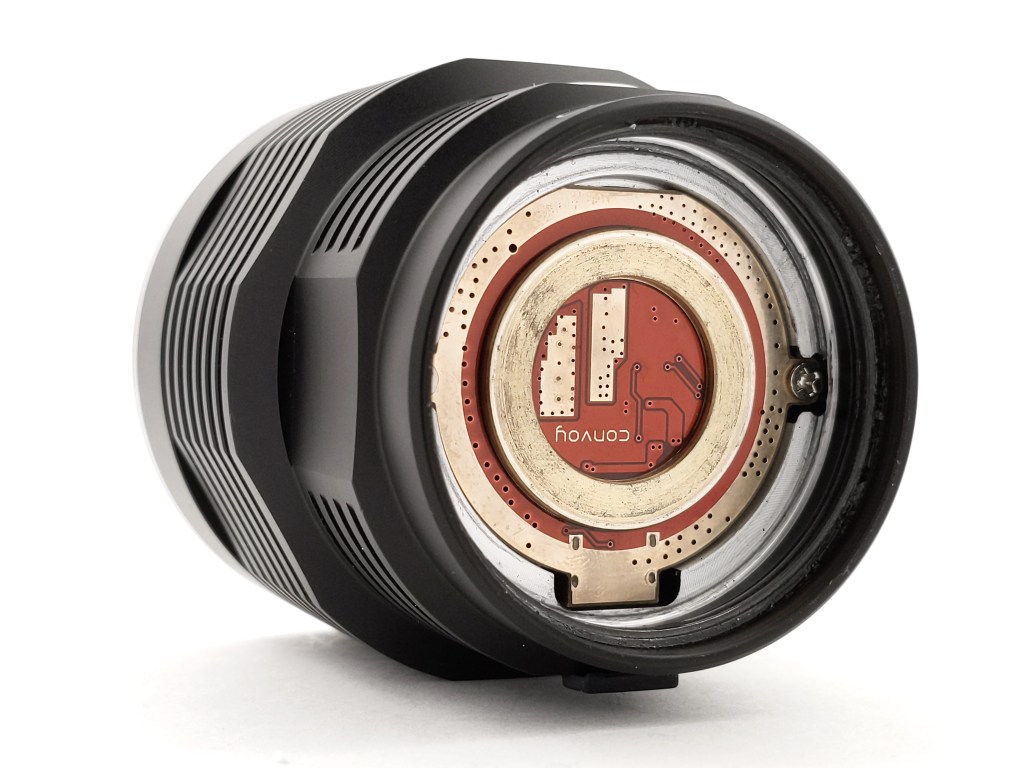

The 4X18A uses a large screw in 40mm driver. It’s super easy to remove since it’s just held in with two screws, but there are several wires coming off of it: two thick ones for the emitter, and four thin ones for the switch. A driver swap here should be relatively easy and there’s tons of space in the driver cavity.
The SBT90.2 emitter in this version is a 3V emitter, so that means there doesn’t need to be any voltage conversion from the batteries. Because of that, this version probably isn’t quite as efficient as the XHP70.2 version which needs a boost driver to drive the 6V emitter from 3.6V cells.

Regulation is good. The only mode that’s affected by battery voltage is Turbo, which is not unusual. It’s worth noting that at 3V, Turbo and High modes will drop to low several seconds after turn on as part of the light’s low voltage warning.
Emitter & Beam

This version of the 4X18A uses the spectacular Luminus SBT90.2 in a 5700K color temperature. This emitter is truly special because it combines the massive brightness you get from something like an Cree XHP70.2 with the throw that you get from something like an XHP35-HI. It’s just phenomenal. It’s a really cool looking emitter too.
I have no idea why the anodizing looks weird inside the head, but it doesn’t affect anything. You can’t see it unless you take the reflector out.
When bouncing the light around in my white photo booth, I measured CCT at 5200K and RA (CRI) at 63 with my Opple Light Master 3. It’s worth noting that it looks pretty green to my eye, but that’s not a problem on a thrower like this. The hotspot is narrow and the spill is bright and wide. There’s a noticeable, but not distracting, purple ring beyond the spill from the AR coating on the lens. My guess is the green tint is coming from that AR coating as well.
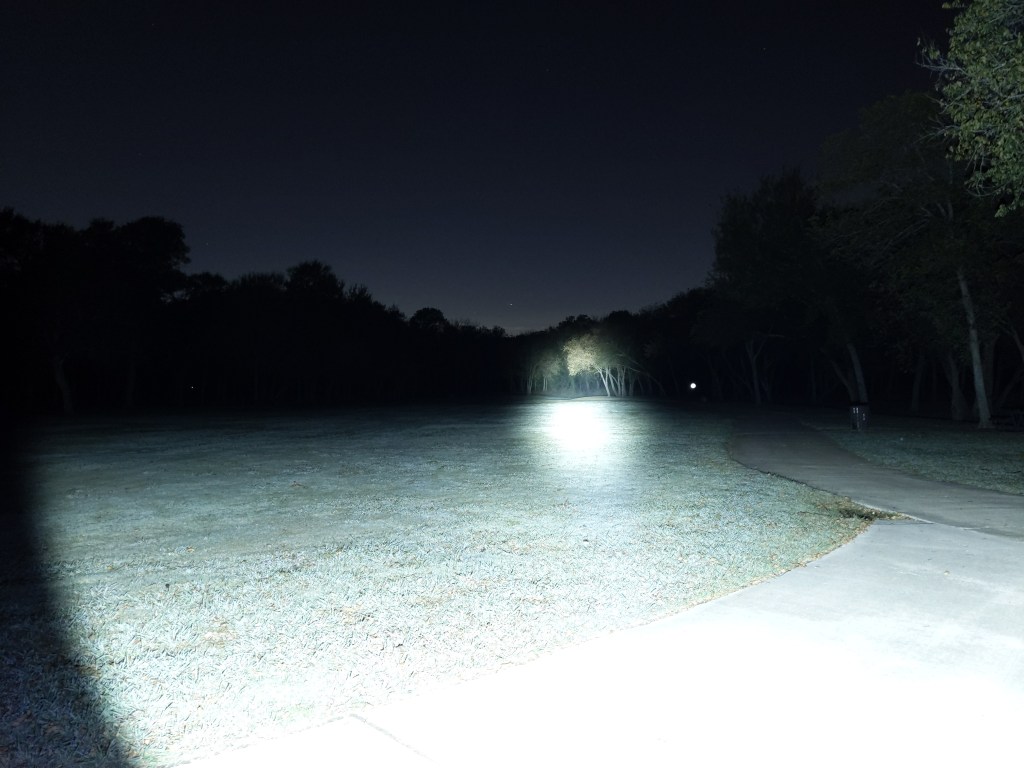
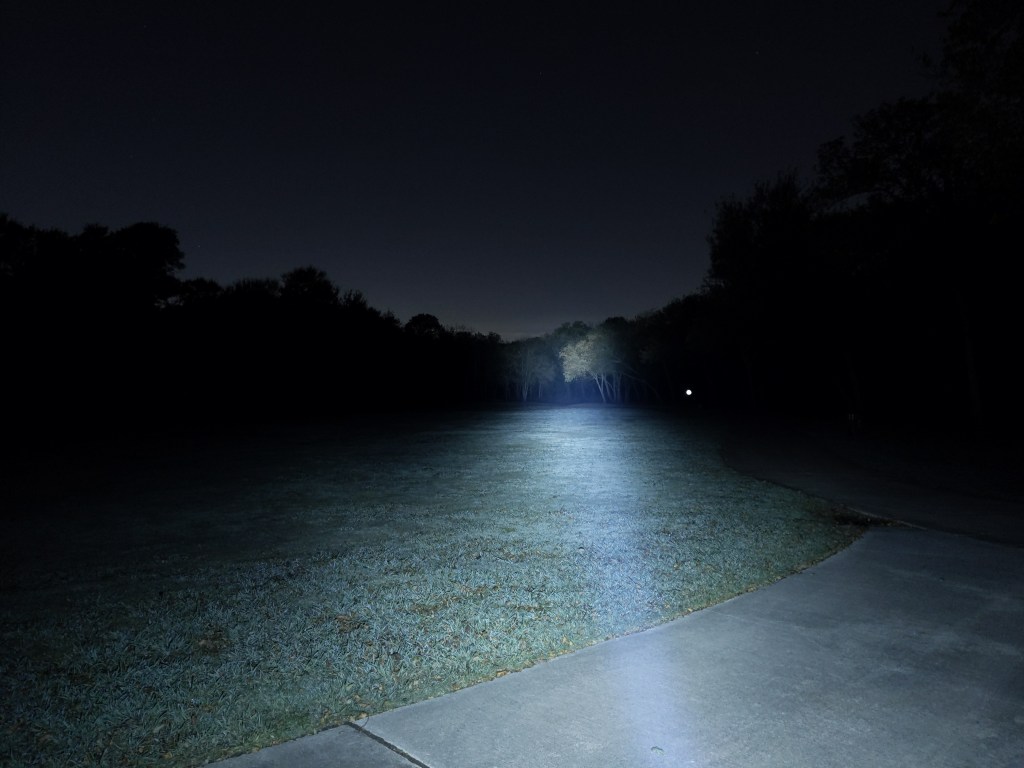






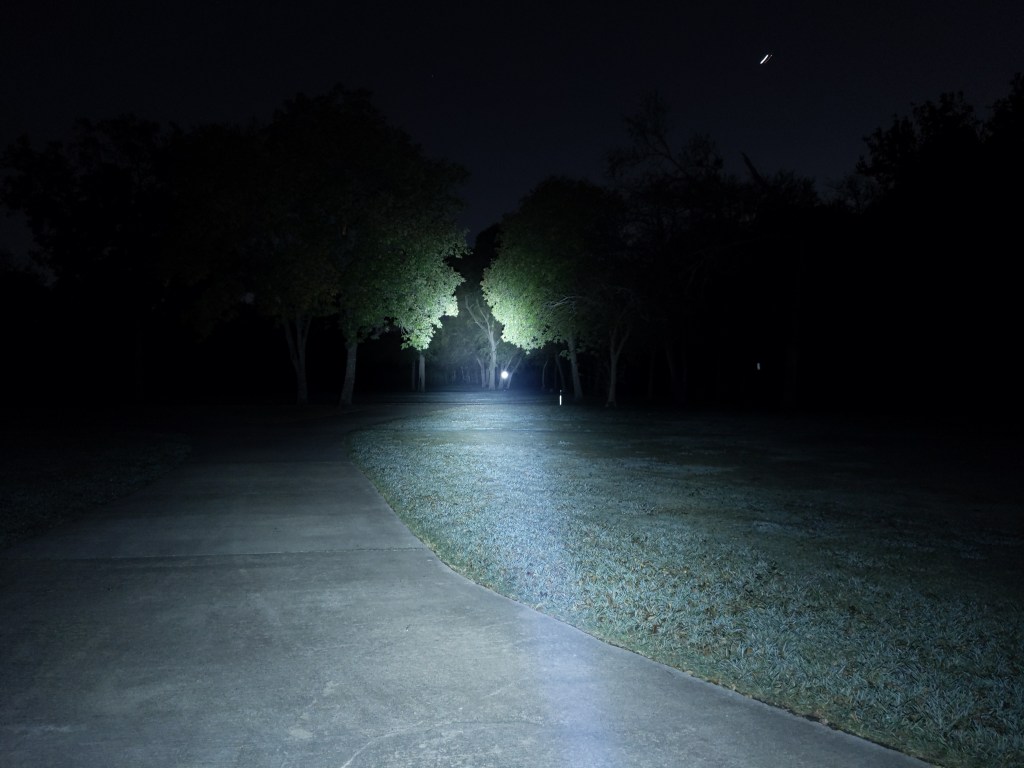


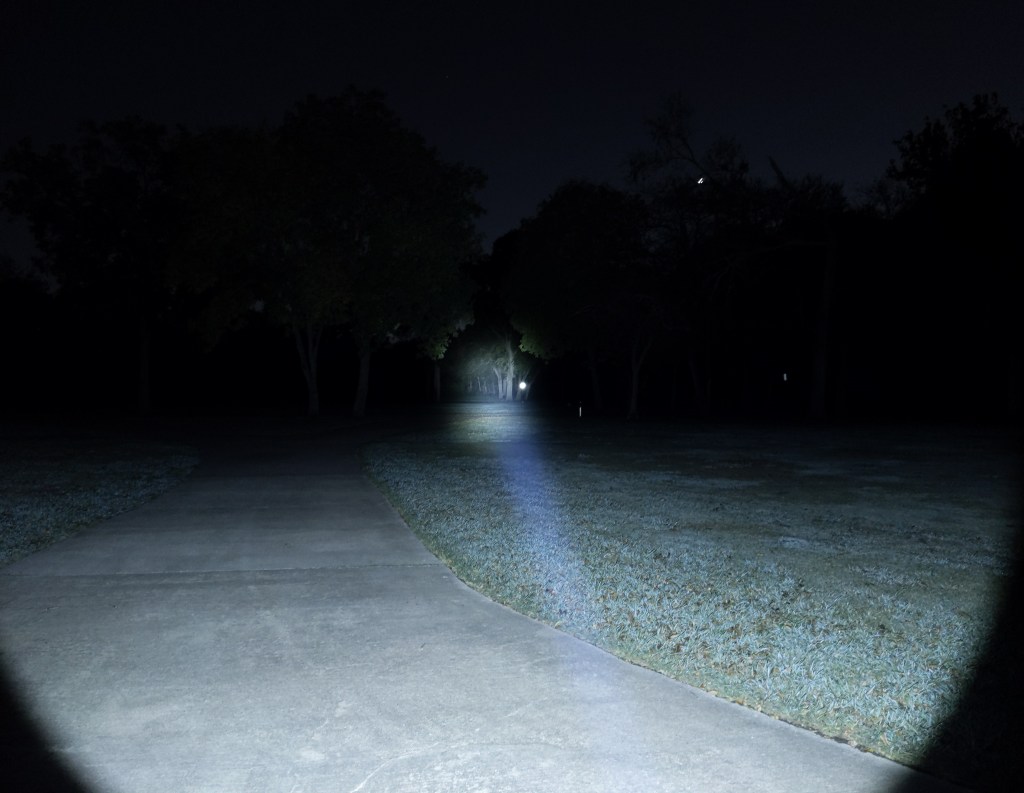


It’s a fairly tight beam, but not to the point that it’s not all that useful like an LEP. The spill is wide and bright. You can see everything around you and objects several hundred meters away. This light is absolutely mind blowing outdoors, like a handheld photon canon. Every time I use it outdoors in public, people around me are audibly amazed. Below are some beamshots from my original review.
Design & Construction
The design is fairly plain, but I like it. It looks beefy and hefty, which it is. It looks like a tool.
Build quality is great, as I’ve come to expect from Convoy. The main threads are thick, square cut, anodized, and lubed. The tail threads aren’t square cut, but you will likely never have a reason to remove the tailcap. There’s a nice hollow spot in the tailcap that could fir a pretty beefy magnet, if you were so inclined.

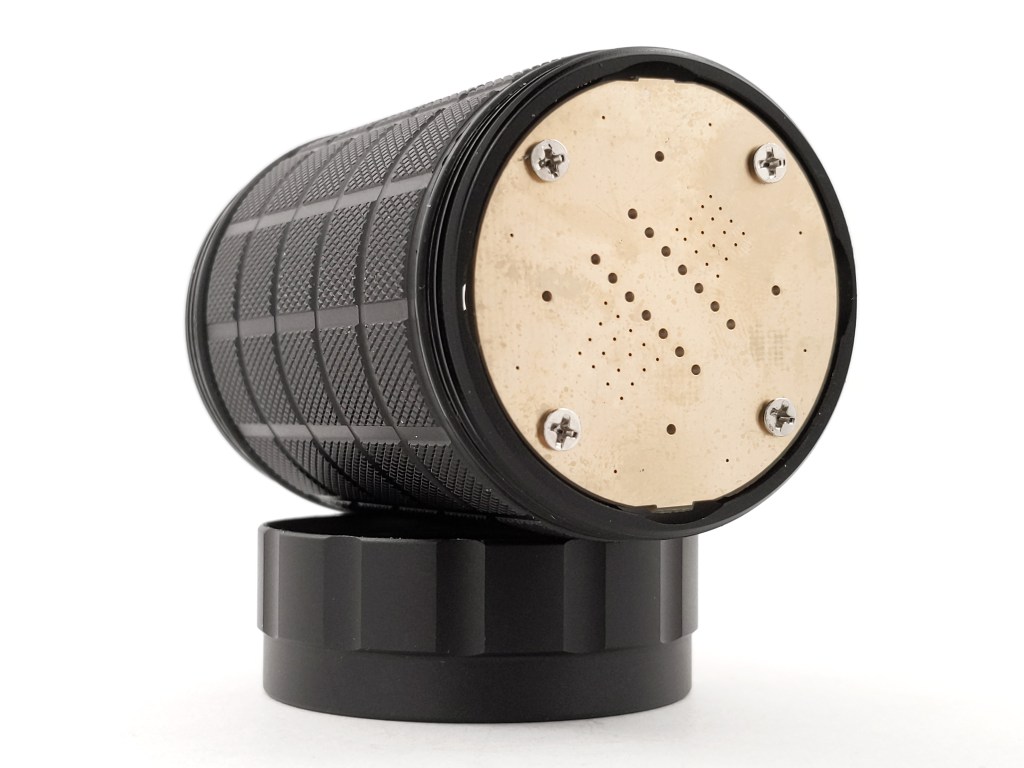

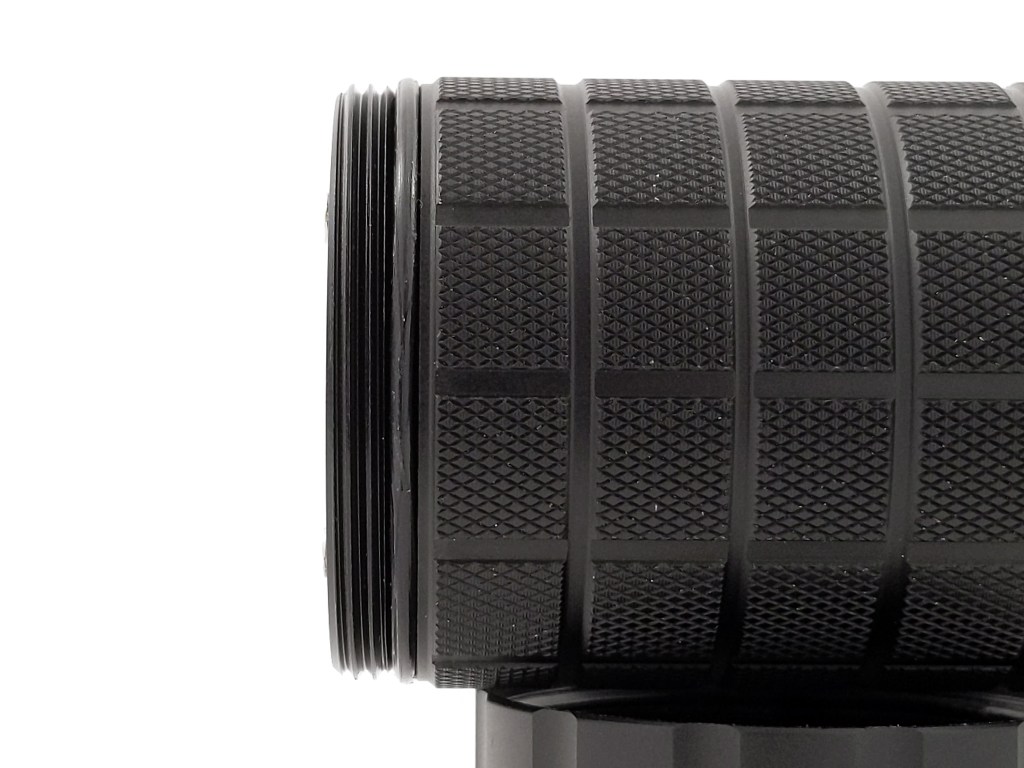

The one significant thing I find lacking about the physical design is the lack of tripod mount. This light would be incredible mounted on a tripod. It would also open up the possibility of using a separate handle. Lots of other soup can lights have this feature and there have been a few times when I really missed not having it. A tripod mount on the side, and some kind of basic separate handle would be worthwhile upgrades for a future version.
Switch
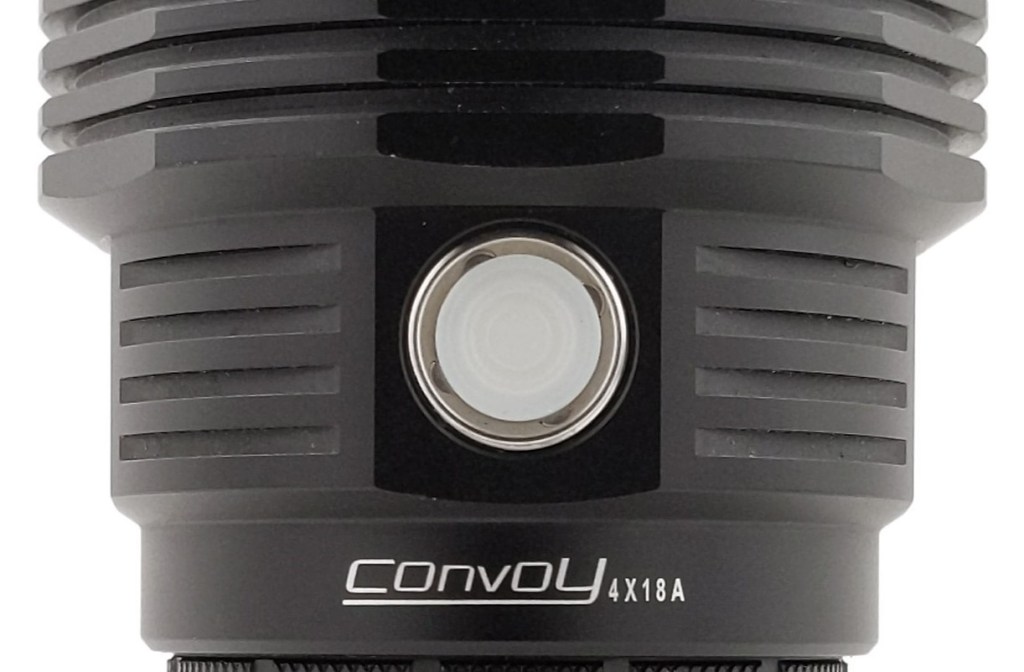
The 4X18A uses an electronic side switch. The boot is translucent white rubber, which allows the red and green backlighting to shine through while the light is charging or when the battery is low. In a future version, I would love to see RGB backlighting here controlled through the firmware (Anduril 2, please).
Carry & Ergonomics
4X18A is fine ergonomically. It’s really big, but it’s not too big to hold onto. I find that a normal forward grip works fine, but I tend to use a modified reverse grip more often. In this grip, I palm the head of the light and use my middle finger to actuate the switch.
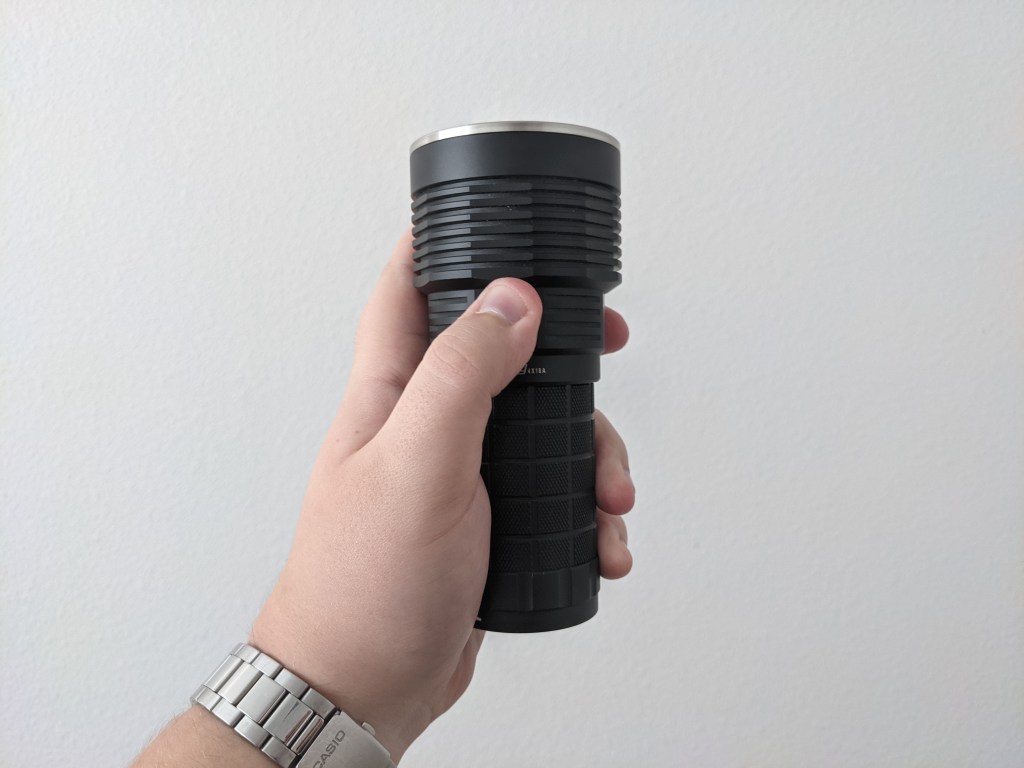


There aren’t any carry options included with the light. It can technically fit in a jacket pocket but you really don’t want to do that because it’s so big and heavy. There’s a lanyard hole, but no lanyard included. I ended up buying one of Convoy’s belt holsters made specifically for 4X18A and it’s great. It’s got extra elastic pockets on the side, with both velcro and snap closure on the belt loop to keep it secure. I highly recommend buying one with your light.

Batteries & Charging
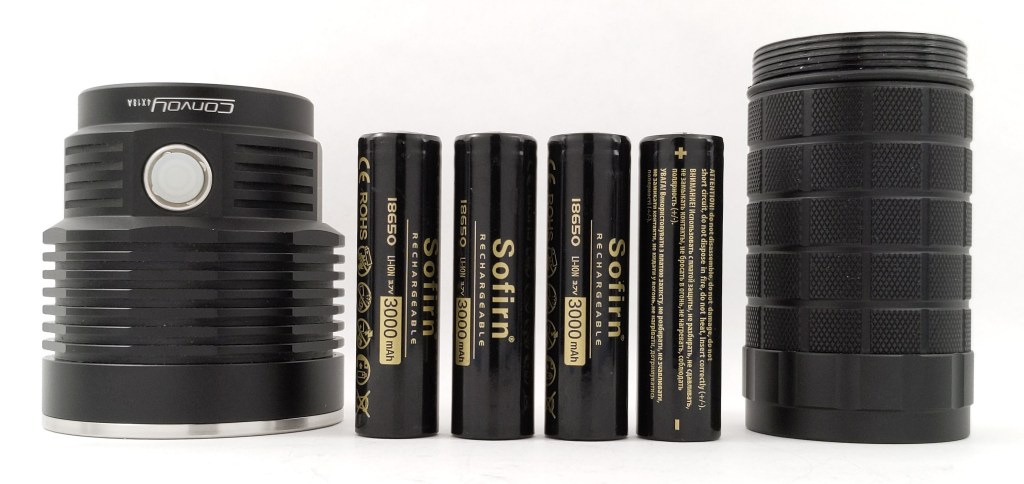
4X18A’s name comes from its use of four 18650 batteries. It only draws about 5 amps per cell, includes an adapter for use with flat tops, and has low voltage protection, so virtually any 18650 will work. Just try make them a matched set if possible, so the batteries stay close in capacity and voltage.
It’s pictured here with four Sofirn 3000mah button tops, but I did all my testing with Sanyo NCR18650GA flat tops. You can get four Liitokala 3500mah cells included with the light from Convoy, and that’s what I recommend doing. I tested max brightness with Samsung 30Q’s, button top Sofirn cells, and flat top NCR18650GA’s and got the exact same output from each of them, so you don’t need high drain cells here.
Note: There is no reverse polarity protection so be very careful when inserting the batteries. If you get one backwards, it and the other cells will short out and feed power into eachother very quickly and cause all sorts of hazardous problems. Fortunately, you may not ever have to open the light because it includes a USB-C charging port on the side.

I want to take a moment to praise Simon for including that flat top battery adapter. Every single light using multiple cells in parallel like this should include one of those adapters. It’s silly that most require button top cells, when a cheap solution like this adapter exists.


Charging is facilitated by a USB-C port on the side of the light. The product page says it charges at 3 amps, which is fairly conservative for four cells. Charging 3500mah cells took over six hours for me, from a 3 amp capable source. Both A-to-C and C-to-C cables work, despite the product page’s warning to only use A-to-C cables.
This port cover is not the most secure I’ve seen. It comes open by accident sometimes so I wouldn’t take this light swimming. It can actually open by itself under the right conditions. If it’s closed when you tighten the battery tube, that will create some pressure inside the light. Then if you turn it on turbo, the air inside will warm up and increase pressure further. It’s just enough to pop that little cover open.

During charging, the switch will glow bright red. When charging is complete, it will turn green. It’s a very bright switch light, so I wouldn’t want this thing charging on my nightstand while I’m trying to sleep.
A problem?
After about a week and a half of use, the LED in my sample started flickering faintly and blinking all while the light is off. Here is a video showing the behavior. I have not seen this reported by anyone else, so I believe mine was just a lemon.
I contacted Simon and he offered to send me a replacement driver for me to install myself. I never took him up on that offer because the problem appeared to go away a couple of weeks later, and I have not noticed it for over four months.
Competition
Here are some lights in the same class and how they compare. I’m not counting 3X21A with SBT90.2 as a competitor because it’s exactly the same light, just with slightly different styling & battery tube.
Convoy L7: Same price, longer and narrower, 2×26650 (or 26800) batteries instead of 4×18650’s, slightly brighter, cleaner and slightly more focused beam, dual-switch UI, no integrated charging, more bonk-factor
Acebeam K30-GT: A little narrower, similar length, one less battery, similar output, a little wider hotspot with less throw, a little lighter, indicator LED, tripod mount & handle, more expensive, no integrated charging, marginally better UI
Noctigon K1 SBT90.2: Similar overall dimensions but much narrower in the body, single 21700 cell instead of 4 18650’s resulting in much lower capacity, better protected charging port, much better UI (Anduril), RGB backlit button, slightly tighter hotspot and a little more throw, more expensive. K1 is a better toy than 4X18A, but 4X18A is a better tool.
This section is not comprehensive. If I didn’t include a particular light here, it doesn’t mean it’s bad or doesn’t deserve to be here. I simply cannot list every possible competitor.
Conclusion
4X18A turned out to be exactly what I had hoped: an affordable, monster thrower with gobs of brightness and runtime. It’s not without problems though. I don’t love the UI, lack of thermal regulation, or lack of a tripod mount. With that said, I think it is the best value SBT90.2 light available, and one of my top five lights I’ve ever used. If you want a high-value searchlight that can wow anyone, I highly recommend 4X18A SBT.












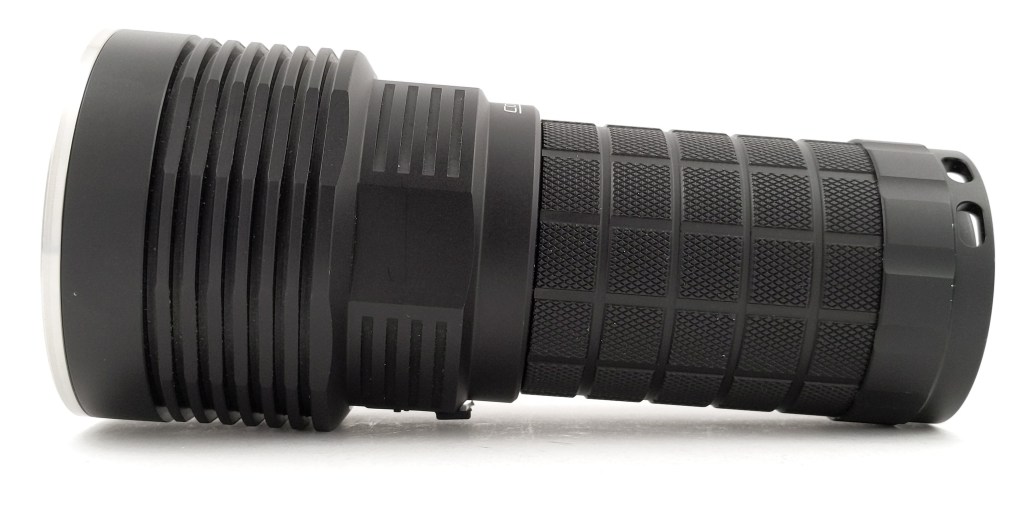
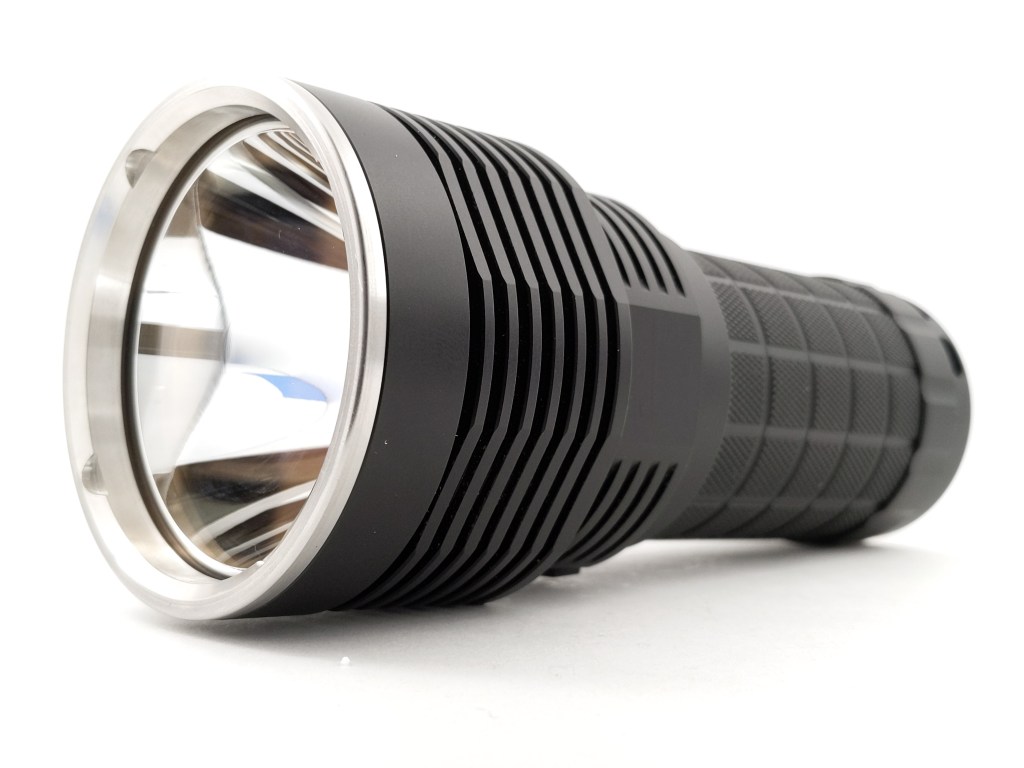

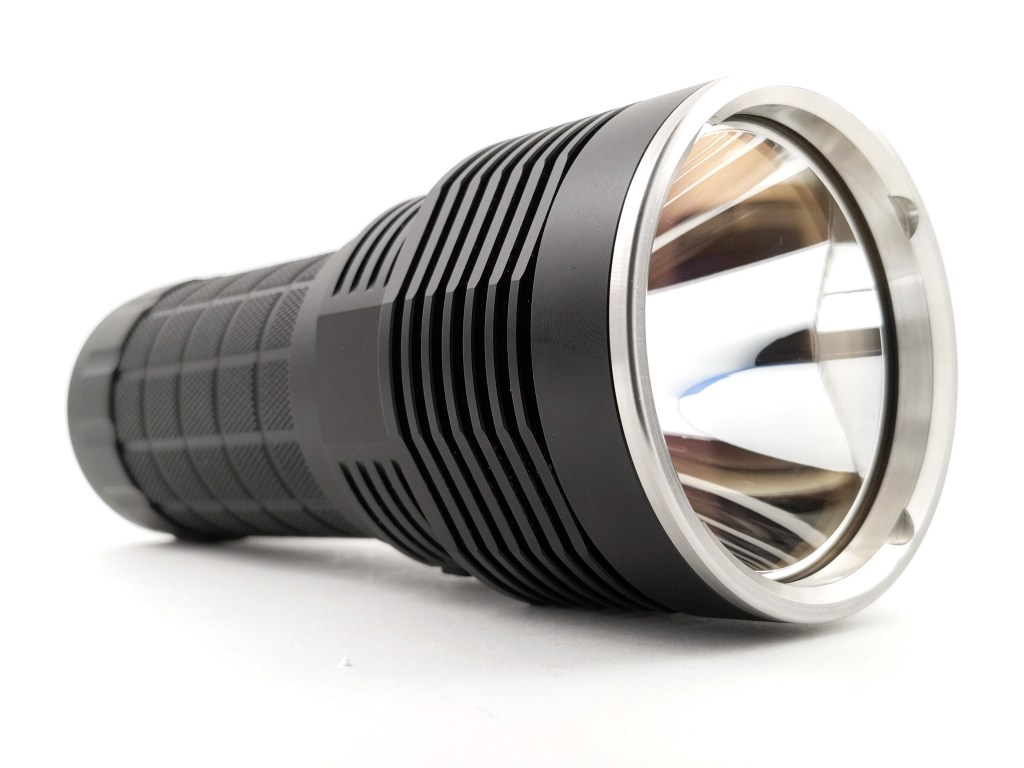

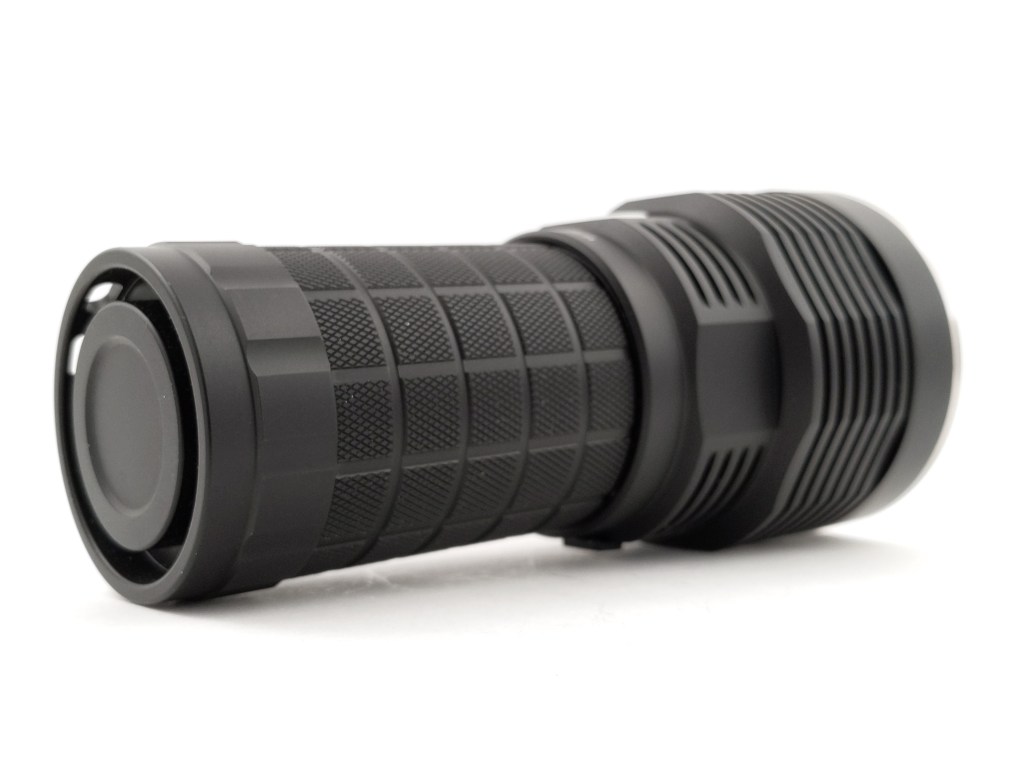


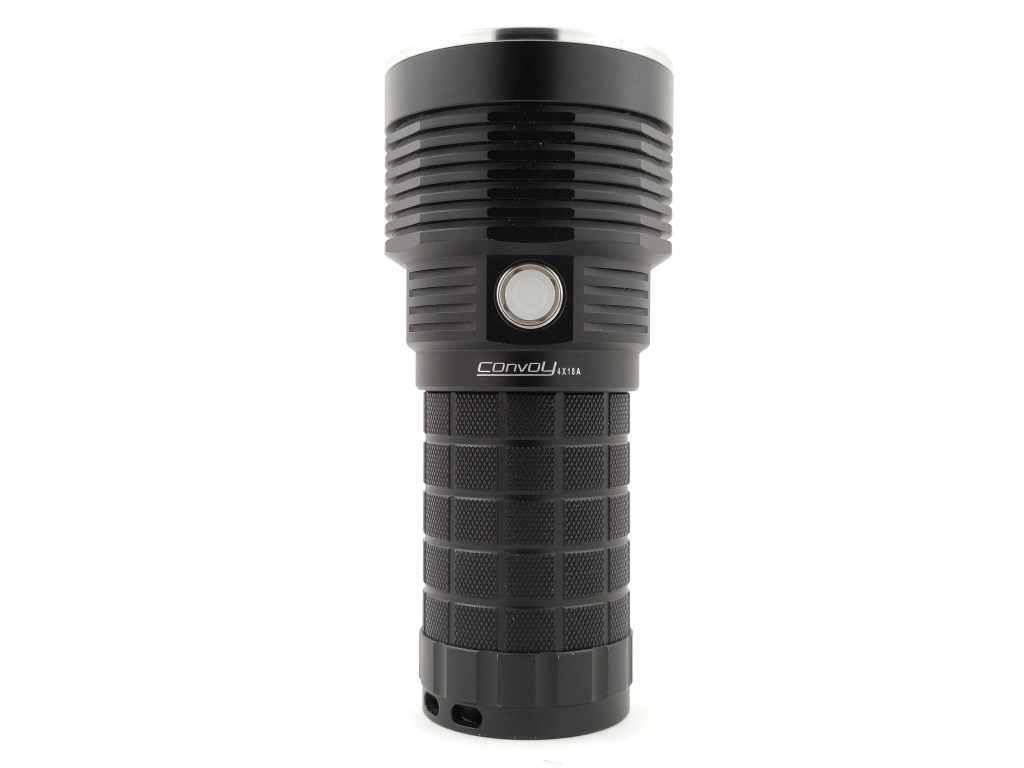
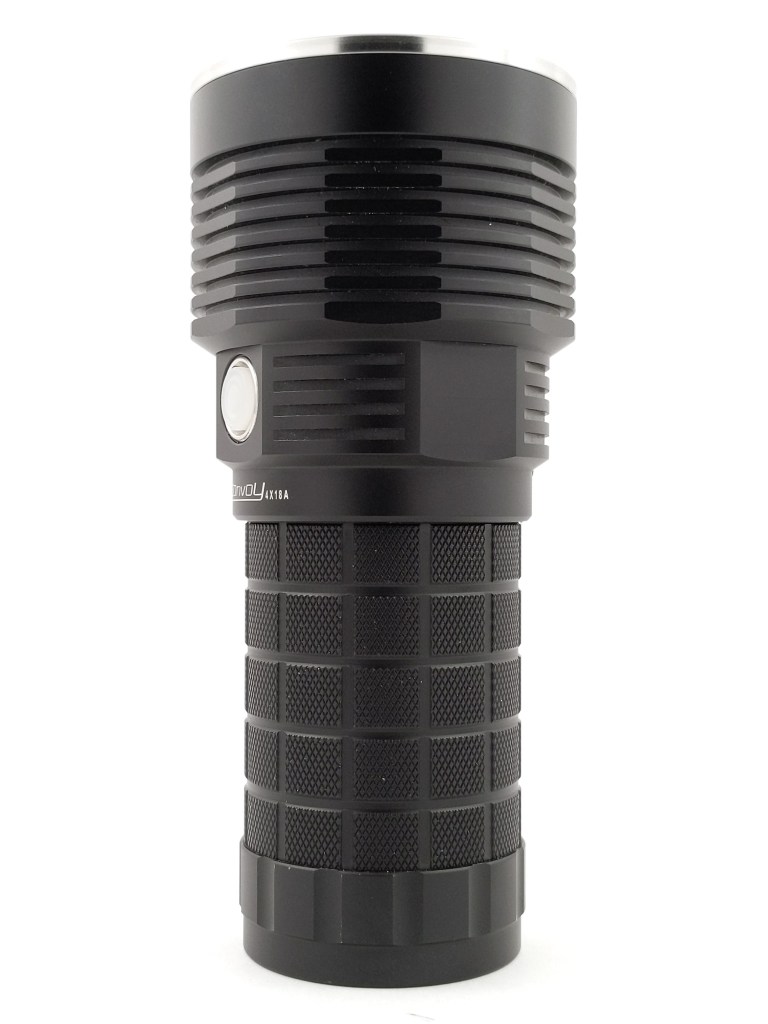



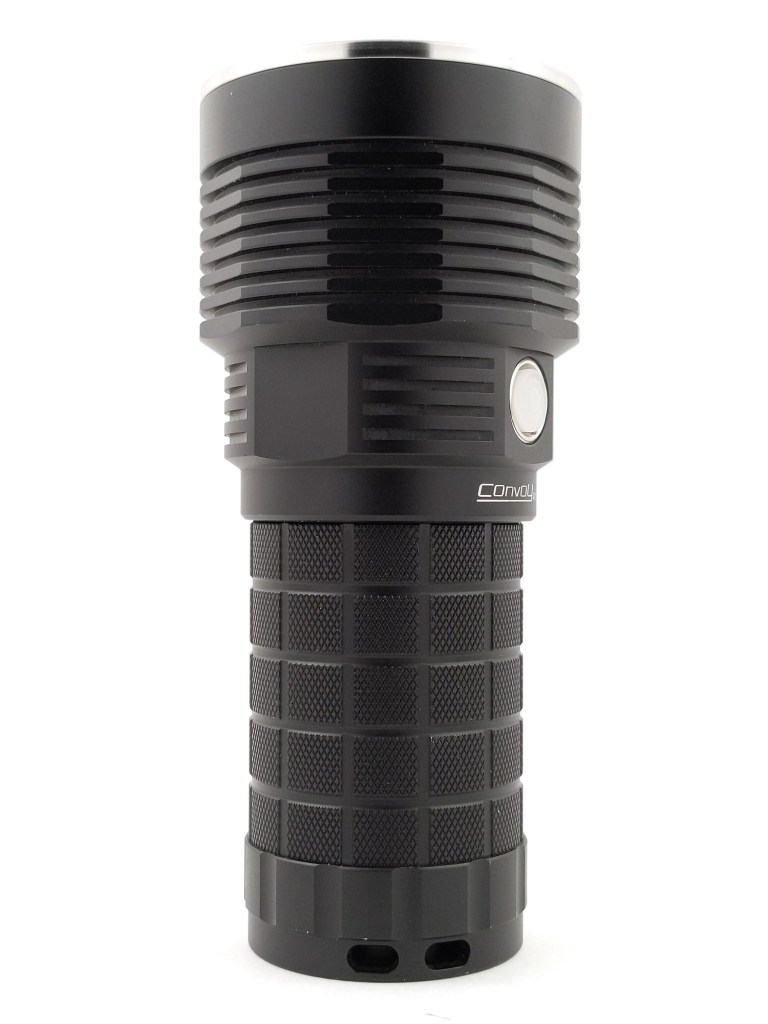



Thanks for a very informative and helpful review. I found the UI chart especially useful. I bought the light based on your review and I am glad that I did! You are right, it is amazing outdoors. I just used it tonight running just below turbo setting for maybe 30 minutes and while the light did get warm, it was still not unpleasant to hold. ( ambient temps in the 60s) Thanks again for a great review.
LikeLike